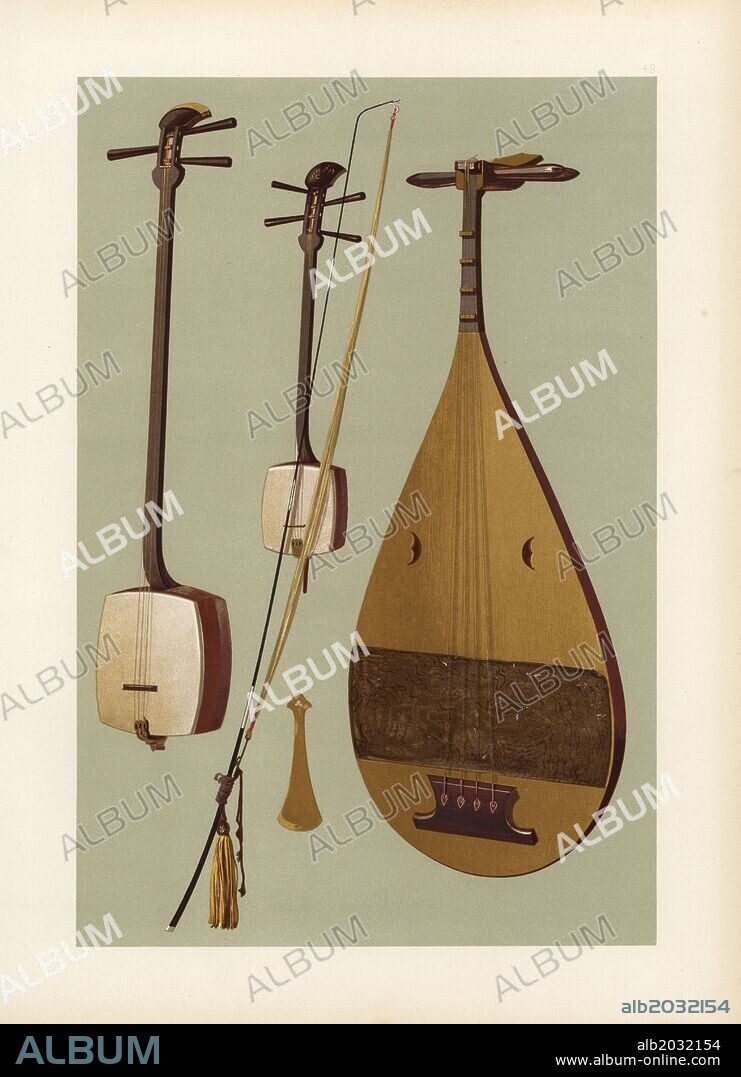alb2032154
Japanese stringed instruments: Siamisen (shamisen), kokiu (fiddle) with long bow and biwa (lute). The Siamesin is the commonest Japanese stringed instrument and is played by the singing girls, geisha. The Kokiu is a kind of fiddle, in its construction very like the Siamesin, only that it is played with a bow (kiu) instead of a plectrum or striker (batsi). The Biwa is a four-string lute-like instrument in the shape of a divided pear, becoming narrower upwards. It is played with a bill-formed batsi, 6 1/2 inches long, made of horn, wood, tortoiseshell, or ivory. Chromolithograph from an illustration by William Gibb from A.J. Hipkins' "Musical Instruments, Historic, Rare and Unique," Adam and Charles Black, Edinburgh, 1888. Alfred James Hipkins (1826-1903) was an English musicologist who specialized in the history of the pianoforte and other instruments. William Gibb was a master illustrator and chromolithographer and illustrated "The Royal House of Stuart" (1890), "Naval and Military Trophies" (1896), and others.

|
Zu einem anderen Lightbox hinzufügen |
|
Zu einem anderen Lightbox hinzufügen |



Haben Sie bereits ein Konto? Anmelden
Sie haben kein Konto? Registrieren
Dieses Bild kaufen

Untertitel:
Siehe automatische Übersetzung
Japanese stringed instruments: Siamisen (shamisen), kokiu (fiddle) with long bow and biwa (lute). The Siamesin is the commonest Japanese stringed instrument and is played by the singing girls, geisha. The Kokiu is a kind of fiddle, in its construction very like the Siamesin, only that it is played with a bow (kiu) instead of a plectrum or striker (batsi). The Biwa is a four-string lute-like instrument in the shape of a divided pear, becoming narrower upwards. It is played with a bill-formed batsi, 6 1/2 inches long, made of horn, wood, tortoiseshell, or ivory. Chromolithograph from an illustration by William Gibb from A.J. Hipkins' "Musical Instruments, Historic, Rare and Unique," Adam and Charles Black, Edinburgh, 1888. Alfred James Hipkins (1826-1903) was an English musicologist who specialized in the history of the pianoforte and other instruments. William Gibb was a master illustrator and chromolithographer and illustrated "The Royal House of Stuart" (1890), "Naval and Military Trophies" (1896), and others.
Bildnachweis:
Album / Florilegius
Freigaben (Releases):
Model: Nein - Eigentum: Nein
Rechtefragen?
Rechtefragen?
Bildgröße:
4272 x 5900 px | 72.1 MB
Druckgröße:
36.2 x 50.0 cm | 14.2 x 19.7 in (300 dpi)
Schlüsselwörter:
BANJO • FARBE • FARBIG • FIEDEL • GEIGE • GEISHA • GESCHICHTE • HISTORISCH • ILLUSTRATION • ILLUSTRATIONS • ILLUSTRATOR • INSTRUMENT • INSTRUMENTE • KUENSTLER • KÜNSTLER • LAUTE • LAUTE, MUSIKINSTRUMENT • LIED • LITHOGRAPH • LITHOGRAPHIE • MUSICAL • MUSIK • MUSIK: LIED • MUSIKINSTR.: GEIGE • MUSIKINSTR.: LAUTE • MUSIKINSTR.: VIOLINE • RAR • SELTEN • SHAMISEN • TECHNIK: LITHOGRAPHIE • VIOLINE • ZEITGESCHICHTE
 Pinterest
Pinterest Twitter
Twitter Facebook
Facebook Link kopieren
Link kopieren Email
Email
